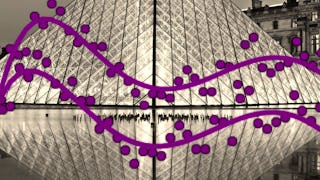This course covers the essential information that every serious programmer needs to know about algorithms and data structures, with emphasis on applications and scientific performance analysis of Java implementations. Part I covers elementary data structures, sorting, and searching algorithms. Part II focuses on graph- and string-processing algorithms.

Enjoy unlimited growth with a year of Coursera Plus for $199 (regularly $399). Save now.

(2,039 reviews)
Skills you'll gain
Details to know
13 assignments
See how employees at top companies are mastering in-demand skills

There are 14 modules in this course
Welcome to Algorithms, Part II.
What's included
1 video2 readings
We define an undirected graph API and consider the adjacency-matrix and adjacency-lists representations. We introduce two classic algorithms for searching a graph—depth-first search and breadth-first search. We also consider the problem of computing connected components and conclude with related problems and applications.
What's included
6 videos2 readings1 assignment
In this lecture we study directed graphs. We begin with depth-first search and breadth-first search in digraphs and describe applications ranging from garbage collection to web crawling. Next, we introduce a depth-first search based algorithm for computing the topological order of an acyclic digraph. Finally, we implement the Kosaraju−Sharir algorithm for computing the strong components of a digraph.
What's included
5 videos1 reading1 assignment1 programming assignment
In this lecture we study the minimum spanning tree problem. We begin by considering a generic greedy algorithm for the problem. Next, we consider and implement two classic algorithm for the problem—Kruskal's algorithm and Prim's algorithm. We conclude with some applications and open problems.
What's included
6 videos2 readings1 assignment
In this lecture we study shortest-paths problems. We begin by analyzing some basic properties of shortest paths and a generic algorithm for the problem. We introduce and analyze Dijkstra's algorithm for shortest-paths problems with nonnegative weights. Next, we consider an even faster algorithm for DAGs, which works even if the weights are negative. We conclude with the Bellman−Ford−Moore algorithm for edge-weighted digraphs with no negative cycles. We also consider applications ranging from content-aware fill to arbitrage.
What's included
5 videos1 reading1 assignment1 programming assignment
In this lecture we introduce the maximum flow and minimum cut problems. We begin with the Ford−Fulkerson algorithm. To analyze its correctness, we establish the maxflow−mincut theorem. Next, we consider an efficient implementation of the Ford−Fulkerson algorithm, using the shortest augmenting path rule. Finally, we consider applications, including bipartite matching and baseball elimination.
What's included
6 videos2 readings1 assignment1 programming assignment
In this lecture we consider specialized sorting algorithms for strings and related objects. We begin with a subroutine to sort integers in a small range. We then consider two classic radix sorting algorithms—LSD and MSD radix sorts. Next, we consider an especially efficient variant, which is a hybrid of MSD radix sort and quicksort known as 3-way radix quicksort. We conclude with suffix sorting and related applications.
What's included
6 videos1 reading1 assignment
In this lecture we consider specialized algorithms for symbol tables with string keys. Our goal is a data structure that is as fast as hashing and even more flexible than binary search trees. We begin with multiway tries; next we consider ternary search tries. Finally, we consider character-based operations, including prefix match and longest prefix, and related applications.
What's included
3 videos2 readings1 assignment
In this lecture we consider algorithms for searching for a substring in a piece of text. We begin with a brute-force algorithm, whose running time is quadratic in the worst case. Next, we consider the ingenious Knuth−Morris−Pratt algorithm whose running time is guaranteed to be linear in the worst case. Then, we introduce the Boyer−Moore algorithm, whose running time is sublinear on typical inputs. Finally, we consider the Rabin−Karp fingerprint algorithm, which uses hashing in a clever way to solve the substring search and related problems.
What's included
5 videos1 reading1 assignment1 programming assignment
A regular expression is a method for specifying a set of strings. Our topic for this lecture is the famous grep algorithm that determines whether a given text contains any substring from the set. We examine an efficient implementation that makes use of our digraph reachability implementation from Week 1.
What's included
5 videos2 readings1 assignment
We study and implement several classic data compression schemes, including run-length coding, Huffman compression, and LZW compression. We develop efficient implementations from first principles using a Java library for manipulating binary data that we developed for this purpose, based on priority queue and symbol table implementations from earlier lectures.
What's included
4 videos1 reading1 assignment1 programming assignment
Our lectures this week are centered on the idea of problem-solving models like maxflow and shortest path, where a new problem can be formulated as an instance of one of those problems, and then solved with a classic and efficient algorithm. To complete the course, we describe the classic unsolved problem from theoretical computer science that is centered on the concept of algorithm efficiency and guides us in the search for efficient solutions to difficult problems.
What's included
4 videos2 readings1 assignment
The quintessential problem-solving model is known as linear programming, and the simplex method for solving it is one of the most widely used algorithms. In this lecture, we given an overview of this central topic in operations research and describe its relationship to algorithms that we have considered.
What's included
4 videos1 reading1 assignment
Is there a universal problem-solving model to which all problems that we would like to solve reduce and for which we know an efficient algorithm? You may be surprised to learn that we do no know the answer to this question. In this lecture we introduce the complexity classes P, NP, and NP-complete, pose the famous P = NP question, and consider implications in the context of algorithms that we have treated in this course.
What's included
6 videos1 reading1 assignment
Instructors


Offered by
Explore more from Algorithms
 Status: Free
Status: FreePrinceton University
 Status: Free
Status: FreeÉcole normale supérieure
 Status: Preview
Status: PreviewNortheastern University
 Status: Free Trial
Status: Free TrialRice University
Why people choose Coursera for their career




Learner reviews
2,039 reviews
- 5 stars
93.58%
- 4 stars
5.24%
- 3 stars
0.48%
- 2 stars
0.24%
- 1 star
0.44%
Showing 3 of 2039
Reviewed on Feb 7, 2020
As always, I learned a lot from the courses from Professor Robert. Really great course, and I would like to recommend to anyone who is interested in programming neatly and elegantly.
Reviewed on Jan 12, 2024
Great quality of academic content. Mr Sedgewick is a great lecturer and the programming tasks, though hard, help you dive deep into the Java implementations.
Reviewed on Feb 27, 2021
Essential information that every serious programmer needs to know about algorithms and data structures, with emphasis on applications and scientific performance analysis of Java implementations.
Frequently asked questions
Once you enroll, you’ll have access to all videos and programming assignments.
No. All features of this course are available for free.
No. As per Princeton University policy, no certificates, credentials, or reports are awarded in connection with this course.
More questions
Financial aid available,





